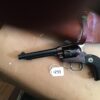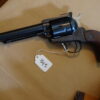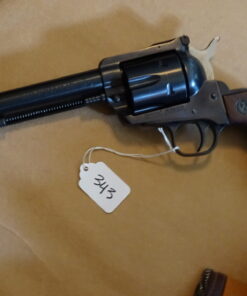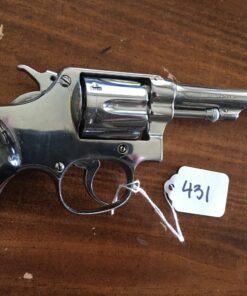Ruger introduced the Blackhawk in 1955. Chambered for the .357 Magnum, the Blackhawk was a simple and strong design, and it sold well. In 1956, as Smith & Wesson was introducing the new .44 Magnum, Ruger quickly developed a variant of the Blackhawk in the new cartridge. Ruger achieved wide popularity with this firearm in a hotly anticipated new cartridge, which was both cheaper and more readily available than the Smith & Wesson Model 29 revolver. According to popular legend, Ruger was able to field a .44 Magnum revolver at nearly the same time as Smith & Wesson due to a Ruger employee finding expended .44 Magnum cartridge cases at a scrapyard and deducing that Smith & Wesson was about to launch a new cartridge.[3][4]
The 1955–1962 Blackhawks are known today as the “Flattop” models, because their adjustable rear sights were not protected by “ears” extending up from the frame as later became standard. From 1962 through 1972, Ruger made the “Three Screw” Blackhawk in various calibers, so called by the number of screws visible on the side of the revolver.
The Flattop and Three Screw Rugers were modernized compared to the Colt Single Action Army, in that they had adjustable sights instead of the Colt’s fixed sights, and they used wire coil springs instead of the Colt’s flat leaf springs. Bill Ruger chose coil springs due to their greater durability, saying that it solved one of the primary weaknesses of the Colt design.
The early models of the Blackhawk still operated the same way as the Colt, in that the hammer was half-cocked to load and unload and that the firearm was not safe to carry with all six chambers loaded due to the hammer resting upon the sixth chamber.[5] In 1973, in order to eliminate accidents occurring from the hammer jarring against a round loaded in the sixth chamber, Ruger introduced the New Model Blackhawk. The New Model Blackhawk did not require the hammer to be half-cocked for loading and unloading, and it employed a transfer bar mechanism which prevented the cartridge under the hammer from being fired without the trigger being pulled. The New Blackhawk was seen as limiting firearms accidents and legal liability.












Reviews
There are no reviews yet.